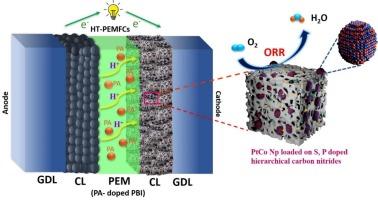Catalytic synergy of PtCo alloy nanoparticles anchored on S, P-doped hierarchical carbon nitrides for efficient and durable oxygen reduction in high-temperature PEMFCs
IF 7.5
1区 工程技术
Q2 ENERGY & FUELS
引用次数: 0
Abstract
Intensified electrochemical corrosion under high-temperature and phosphoric acid conditions poses a significant challenge to the catalysts in high-temperature proton exchange membrane fuel cells (HT-PEMFCs). Herein, a S, P-doped hierarchical porous carbon nitride (S, P-HCN) supported PtCo alloy catalyst was developed to address this issue. The multilayered porous structure of S, P-HCN ensures high metal dispersion, a large specific surface area, and enhanced mass transfer. The PtCo/S, P-HCN catalyst exhibits remarkable performance, with specific activity (1.27 mA cmPt-2 at 0.80 V), mass activity (0.51 mA µgPt-1 at 0.80 V), and electrochemical active surface area (ECSA) (39.9 m2 g-1Pt), surpassing commercial 20 % Pt/C by 2–3 times. Durability tests over 5000 potential cycles reveal excellent retention of mass activity (84 %) and specific activity (83.2 %) at 0.80 V, with only a minor 14 mV shift in half-wave potential. This enhancement stems from the synergistic effects between PtCo alloy nanoparticles and S, P-HCN, which modulate Pt- electronic structure, strengthen metal-support interactions, and boost catalytic efficiency. Single-cell HT-PEMFC studies demonstrate a peak power density of 377.4 mW cm−2 for PtCo/S, P-HCN, comparable to commercial Pt/C (398 mW cm−2), with reduced voltage degradation at low current densities. This work presents a promising approach for improving cathode materials and advancing HT-PEMFC performance.

PtCo合金纳米颗粒锚定在S, p掺杂的分层碳氮化物上的催化协同作用,用于高温pemfc中高效持久的氧还原
高温和磷酸条件下电化学腐蚀加剧对高温质子交换膜燃料电池(ht - pemfc)催化剂提出了重大挑战。为了解决这一问题,本文开发了一种掺S, p的分层多孔氮化碳(S, P-HCN)负载PtCo合金催化剂。S, P-HCN的多层多孔结构保证了高的金属分散性、大的比表面积和增强的传质。PtCo/S, P-HCN催化剂表现出优异的性能,其比活性(0.80 V时为1.27 mA cmPt-2)、质量活性(0.51 mAµgPt-1)和电化学活性表面积(39.9 m2 g-1Pt)均超过20% Pt/C的2-3倍。超过5000个电位循环的耐久性测试显示,在0.80 V下,质量活性(84%)和比活性(83.2%)保持良好,半波电位只有14 mV的微小位移。这种增强是由于PtCo合金纳米颗粒与S, P-HCN之间的协同作用,它调节了Pt-电子结构,加强了金属-载体相互作用,提高了催化效率。单电池HT-PEMFC研究表明,PtCo/S, P-HCN的峰值功率密度为377.4 mW cm - 2,与商用Pt/C (398 mW cm - 2)相当,并且在低电流密度下降低了电压退化。这项工作为改进阴极材料和提高HT-PEMFC性能提供了一种有前途的方法。
本文章由计算机程序翻译,如有差异,请以英文原文为准。
求助全文
约1分钟内获得全文
求助全文
来源期刊

Fuel
工程技术-工程:化工
CiteScore
12.80
自引率
20.30%
发文量
3506
审稿时长
64 days
期刊介绍:
The exploration of energy sources remains a critical matter of study. For the past nine decades, fuel has consistently held the forefront in primary research efforts within the field of energy science. This area of investigation encompasses a wide range of subjects, with a particular emphasis on emerging concerns like environmental factors and pollution.
 求助内容:
求助内容: 应助结果提醒方式:
应助结果提醒方式:


